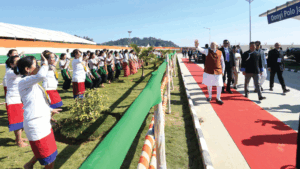In 2014, PM Modi resolved to replace this practice with “Purvodaya”, a mission to bring development, especially basic infrastructure to the Northeast. He not only declared the region as a “priority area”, but also pledged to turn it into a “growth engine” for India.
Jyotiraditya Scindia
For decades, the road to India’s Northeast region had remained a long and lonely one. What people would say about the eons it took for innovations in the West to reach India held true, in the Indian context, for the Northeast. Resultantly, the region remained stuck on the opposite side of progress and development.
In 2014, PM Modi resolved to replace this practice with “Purvodaya”, a mission to bring development, especially basic infrastructure to the Northeast. He not only declared the region as a “priority area”, but also pledged to turn it into a “growth engine” for India.
Aviation for All
The ambitious vision was quickly infused into policy. He mandated all the ministries to spend at least 10% of their budget in the northeastern region. In civil aviation, a separate Rs 500 crore budget was allocated to open the doors of air connectivity in the Northeast.

Airports in five northeastern states, namely, Mizoram, Meghalaya, Sikkim, Arunachal Pradesh and Nagaland have seen flights take off for the first time in 75 years, and account for almost 27% of the total air traffic movements in the northeastern region
Since then, inclusive growth in aviation – a concept that would have sounded conjectural a decade ago – has become the protagonist of India’s civil aviation story.
–In 68 years, the Northeast housed nine airports.
–It jumped to 16 in a short span of eight years.
–Consequently, air traffic movement in the Northeast has seen a phenomenal 113% rise since 2014.
However, the actual success of the six-year-old UDAN (Ude Desh ka Aam Nagrik) scheme can be measured not in the number of flights plied, but the multiplier effect it has had on the local economies of hitherto unserved regions. Assam’s World War II era Rupsi airport is a good case in point, which, having given a fillip to the local tourism industry, serves more than 23,000 passengers in a year.

Airports in five northeastern states, namely, Mizoram, Meghalaya, Sikkim, Arunachal Pradesh and Nagaland have seen flights take off for the first time in 75 years, and account for almost 27% of the total air traffic movements in the northeastern region. Sikkim’s first airport since Independence, Pakyong, as well as Lilabari and Tezpur airports in Assam have been key gateways for travellers from all over the world. The latest in line is Arunachal, which has also been brought on the civil aviation map for the first time.
Putting Military Airstrips to civilian use
Apart from developing new airports like Tezu and Hollongi, we also took to the novel idea of developing Advance Landing Grounds (ALGs) for commercial air services to connect the last mile.
ALGs were airstrips which were built shortly before the 1962 Sino-India war, and are strategically important for India.
Two ALGs in Pasighat and Ziro have been connected in the first phase through a “Made in India” Dornier 228 aircraft.
ALGs in Mechuka, Tuting, Vijaynagar will be connected in the subsequent phases in 2023-24.
In the same time period, the region will also witness a sprouting of heliports in the remotest corners, making the Northeast one of the most successful flag bearers of democratisation of air travel.
Out of 132 routes awarded (and to be made functional) under the UDAN 4.2 round, 24 routes (ie 18%) belong to the Northeast region. The routes have been planned in a way that ensures connectivity both vertically and horizontally, ie, within the Northeast region as well as, connectivity with the rest of India
Interestingly, the civil aviation sector has also presented a new paradigm for pace of development in the Northeast. For instance, the new Rs 650-crore greenfield airport in Hollongi will now be operationalised – in a span of just three years from the time the PM laid the foundation stone.
Farm produce takes flight
Through Krishi UDAN, it now takes only a few days to transport special agri-produce, like Assamese lemons and king chillies from Guwahati to London. Currently, out of the 58 airports involved in this scheme, 25 are from the Northeast, hilly regions and islands.
Supplemented with the imminent rise in rail and road connectivity, the northeastern region is poised for an upturn in private investments from across the world. This journey from “remote to renowned” will be driven by our strong arsenal of resources, implementation prowess and realistic planning for the future.
Out of 132 routes awarded (and to be made functional) under the UDAN 4.2 round, 24 routes (ie 18%) belong to the Northeast region. The routes have been planned in a way that ensures connectivity both vertically and horizontally, ie, within the Northeast region as well as, connectivity with the rest of India. In fact, in keeping with the PM’s “Act East Policy”, two international routes – between Imphal-Mandalay and Agartala-Chittagong solicited interest from our airlines, and will be operationalised soon.
As India takes concrete steps towards realising the vision of PM Modi’s “Aatmanirbhar Bharat”, it will be a matter of pride to see the Northeast region leading India’s economic prosperity from the front. A strong civil aviation environment will only bring us closer to this dream sooner.
(The writer is Union Minister for Civil Aviation & Steel, Government of India)


